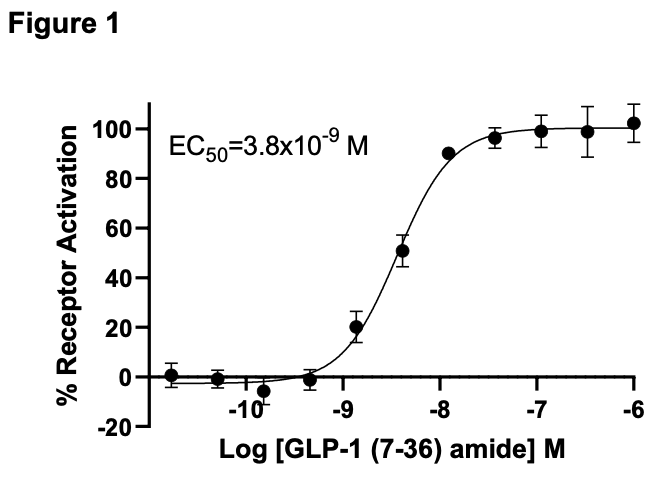Product Information
Catalog Number:
DCA1267BA2
Lot Number:
DCA1267BA2-031723
Quantity:
1 vial (4 x 106) frozen cells
Freeze Medium:
Cellbanker 2
Host cell:
HEK293T β-ARRESTIN2
Transfection:
Expression vector containing full-length human GLP1R cDNA (GenBank Accession Number NM_002062) with FLAG tag sequence at N-terminus and ARRB2 cDNA (GenBank Accession Number NM_004313.3)
Recommended Storage:
Liquid nitrogen upon receiving
Propagation Medium: DMEM, 10% FBS
Data Sheet
Background: Glucagon-like peptide-1 receptor (GLP1R) is a G protein-coupled receptor for the endogenous insulinotropic peptide glucagon-like peptide-1 (GLP-1). GLP1R is expressed in pancreatic cells and the nervous system, and mediate the effects of GLP-1 in regulating glucose homeostasis through multiple mechanisms including direct actions on the endocrine pancreas and indirect activation of central nervous system controlling gastric emptying, satiety, and body weight. In the brain, receptor activation elicits neurotrophic actions through protection against metabolic and oxidative insults. GLP1R is also implicated in plasticity, memory, and learning. Thus, GLP1R is a potential therapeutic target for both cognitive-enhancing and neuroprotective agents and in the treatment of stroke and Parkinsonism.
Application: Functional assays

Figure 1. Dose-dependent stimulation from arrestin recruitment upon treatment with ligand, measured with MULTISCREENTM β-Arrestin Assay Kit (Multispan MSBA01).
References:
During et al. (2003) Glucagon-like peptide-1 receptor is involved in learning and neuroprotection. Nature Med 9:1173-1179.
Dillon et al. (1993) Cloning and functional expression of the human glucagon-like peptide-1 (GLP-1) receptor. Endocrinology 133:1907-1910.
Stoffel et al. (1993) Human glucagon-like peptide-1 receptor gene: localization to chromosome band 6p21 by fluorescence in situ hybridization and linkage of a highly polymorphic simple tandem repeat DNA polymorphism to other markers on chromosome 6. Diabetes 42:1215-1218.
